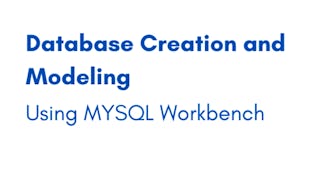In this course you will experience the process of defining, creating, and managing relational database tables using the SQL language. Tables are used as the containers for the data in a database. As such, the structure, or makeup, of each table in a relational database is critical, since it must be designed and created specifically to meet the needs of the data it will contain. The table’s structure indicates which pieces of data are stored in a table, as well as the type and size of each piece of data.



(323 reviews)
Recommended experience
What you'll learn
Create a relational table with SQL code.
Alter the structure of an existing table with SQL code.
Identify the attributes of a relational table.
Skills you'll practice
Details to know

Add to your LinkedIn profile
Only available on desktop
See how employees at top companies are mastering in-demand skills

Learn, practice, and apply job-ready skills in less than 2 hours
- Receive training from industry experts
- Gain hands-on experience solving real-world job tasks
- Build confidence using the latest tools and technologies

About this Guided Project
Learn step-by-step
In a video that plays in a split-screen with your work area, your instructor will walk you through these steps:
The CREATE TABLE Command
Rules for Relational Tables
Adding Constraints
The ALTER Command
Build a Database with a Script
Recommended experience
Learners who are targeting careers in programming, web development, or data analysis.
4 project images
Instructor

Offered by
How you'll learn
Skill-based, hands-on learning
Practice new skills by completing job-related tasks.
Expert guidance
Follow along with pre-recorded videos from experts using a unique side-by-side interface.
No downloads or installation required
Access the tools and resources you need in a pre-configured cloud workspace.
Available only on desktop
This Guided Project is designed for laptops or desktop computers with a reliable Internet connection, not mobile devices.
Why people choose Coursera for their career




Learner reviews
323 reviews
- 5 stars
70.89%
- 4 stars
24.14%
- 3 stars
3.40%
- 2 stars
0.61%
- 1 star
0.92%
Showing 3 of 323
Reviewed on Jun 15, 2020
Its too much easy, was expecting more topics being covered.
Reviewed on May 24, 2020
I M very much satisfied with this course (project).
Reviewed on May 28, 2020
It is good for beginners to acknowledge very efficiently about the topic.
You might also like

Coursera Project Network

Coursera Project Network

Coursera Project Network

Coursera Project Network
New to Data Management? Start here.

Open new doors with Coursera Plus
Unlimited access to 10,000+ world-class courses, hands-on projects, and job-ready certificate programs - all included in your subscription
Advance your career with an online degree
Earn a degree from world-class universities - 100% online
Join over 3,400 global companies that choose Coursera for Business
Upskill your employees to excel in the digital economy
Frequently asked questions
By purchasing a Guided Project, you'll get everything you need to complete the Guided Project including access to a cloud desktop workspace through your web browser that contains the files and software you need to get started, plus step-by-step video instruction from a subject matter expert.
Because your workspace contains a cloud desktop that is sized for a laptop or desktop computer, Guided Projects are not available on your mobile device.
Guided Project instructors are subject matter experts who have experience in the skill, tool or domain of their project and are passionate about sharing their knowledge to impact millions of learners around the world.


